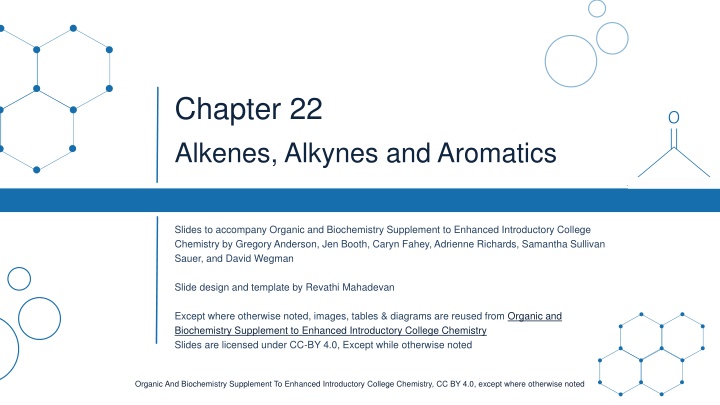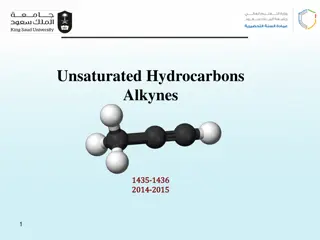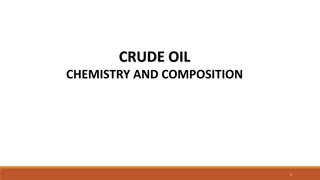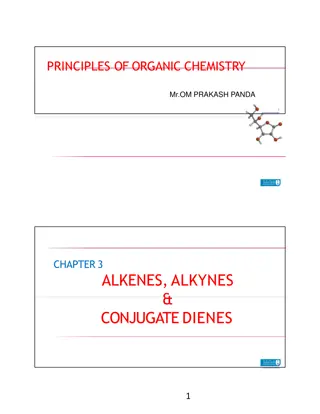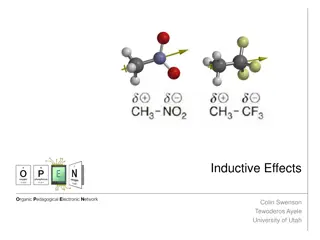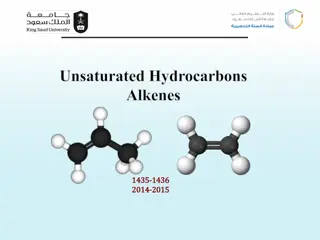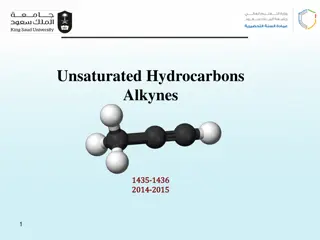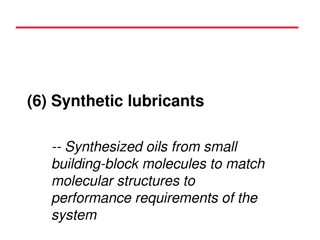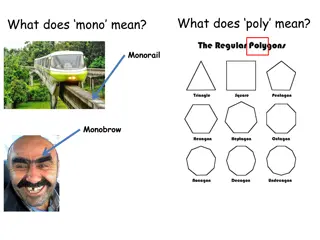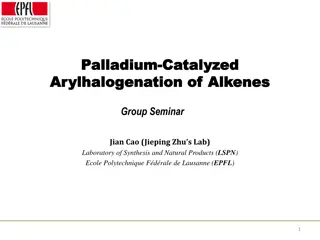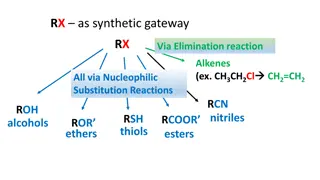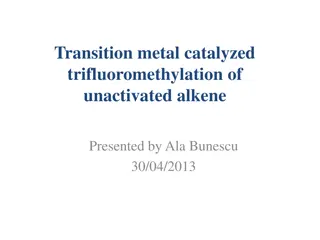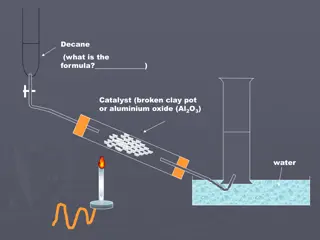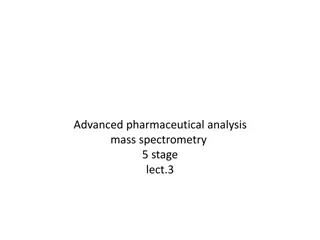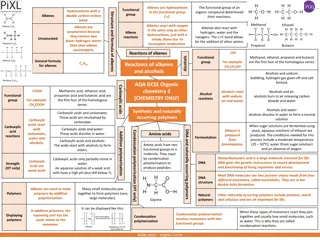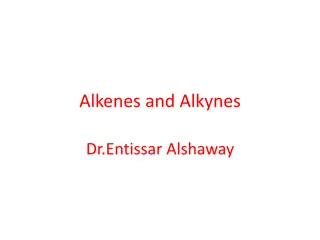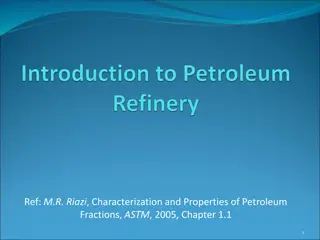Chapter 22: Alkenes, Alkynes and Aromatics
Explore the properties and structures of alkenes through detailed slides and images, including the general formulas of alkanes, alkenes, and alkynes. Discover the physical properties of selected alkenes such as ethene, propene, and 1-butene. Delve into the vibrant world of organic chemistry with engaging visuals and informative content.
Download Presentation

Please find below an Image/Link to download the presentation.
The content on the website is provided AS IS for your information and personal use only. It may not be sold, licensed, or shared on other websites without obtaining consent from the author.If you encounter any issues during the download, it is possible that the publisher has removed the file from their server.
You are allowed to download the files provided on this website for personal or commercial use, subject to the condition that they are used lawfully. All files are the property of their respective owners.
The content on the website is provided AS IS for your information and personal use only. It may not be sold, licensed, or shared on other websites without obtaining consent from the author.
E N D
Presentation Transcript
Chapter 22 Alkenes, Alkynes and Aromatics O Slides to accompany Organic and Biochemistry Supplement to Enhanced Introductory College Chemistry by Gregory Anderson, Jen Booth, Caryn Fahey, Adrienne Richards, Samantha Sullivan Sauer, and David Wegman Slide design and template by Revathi Mahadevan Except where otherwise noted, images, tables & diagrams are reused from Organic and Biochemistry Supplement to Enhanced Introductory College Chemistry Slides are licensed under CC-BY 4.0, Except while otherwise noted Organic And Biochemistry Supplement To Enhanced Introductory College Chemistry, CC BY 4.0, except where otherwise noted Organic And Biochemistry Supplement To Enhanced Introductory College Chemistry, CC BY 4.0, except where otherwise noted
Figure 22.0a Figure 22.0a. Tomatoes (Credit: Tomato by Softeis, CC BY-SA 3.0) Organic And Biochemistry Supplement To Enhanced Introductory College Chemistry, CC BY 4.0, except where otherwise noted Organic And Biochemistry Supplement To Enhanced Introductory College Chemistry, CC BY 4.0, except where otherwise noted
Figure 22.0b Figure 22.0b: The bright red colour of tomatoes is due to lycopene - a polyene. (credit: Image by Jeff Dahl, PDM). Organic And Biochemistry Supplement To Enhanced Introductory College Chemistry, CC BY 4.0, except where otherwise noted Organic And Biochemistry Supplement To Enhanced Introductory College Chemistry, CC BY 4.0, except where otherwise noted
Figure 22.1a Figure 22.1a. The general formulas of alkanes, alkenes and alkynes (credit: Intro Chem: GOB (V. 1.0)., CC BY-NC-SA 3.0). Organic And Biochemistry Supplement To Enhanced Introductory College Chemistry, CC BY 4.0, except where otherwise noted Organic And Biochemistry Supplement To Enhanced Introductory College Chemistry, CC BY 4.0, except where otherwise noted
Figure 22.1b Figure 22.1b. Expanded structures, ball-and-stick structures, and space-filling models for the alkenes ethene, propene, and 1-butene are shown. (credit: Chemistry (OpenStax), CC BY 4.0) Organic And Biochemistry Supplement To Enhanced Introductory College Chemistry, CC BY 4.0, except where otherwise noted Organic And Biochemistry Supplement To Enhanced Introductory College Chemistry, CC BY 4.0, except where otherwise noted
Table 22.1a Table 22.1a. Physical Properties of Some Selected Alkenes Condensed Structural Formula IUPAC Name Molecular Formula Melting Point ( C) Boiling Point ( C) ethene C2H4 CH2=CH2 169 104 propene C3H6 CH2=CHCH3 185 47 1-butene C4H8 CH2=CHCH2CH3 185 6 1-pentene C5H10 CH2=CH(CH2)2CH3 138 30 1-hexene C6H12 CH2=CH(CH2)3CH3 140 63 1-heptene C7H14 CH2=CH(CH2)4CH3 119 94 1-octene C8H16 CH2=CH(CH2)5CH3 102 121 Source: "13.1: Alkenes: Structures and Names" In Basics of GOB Chemistry (Ball et al.), CC BY-NC-SA 4.0. Organic And Biochemistry Supplement To Enhanced Introductory College Chemistry, CC BY 4.0, except where otherwise noted Organic And Biochemistry Supplement To Enhanced Introductory College Chemistry, CC BY 4.0, except where otherwise noted
Figure 22.1c Figure 22.1c. The structural representation of CH2=CH2(credit: Intro Chem: GOB (V. 1.0)., CC BY-NC- SA 3.0). Organic And Biochemistry Supplement To Enhanced Introductory College Chemistry, CC BY 4.0, except where otherwise noted Organic And Biochemistry Supplement To Enhanced Introductory College Chemistry, CC BY 4.0, except where otherwise noted
Figure 22.1d Figure 22.1d. Ethene and Propene. The ball-and-spring models of ethene/ethylene (a) and propene/propylene (b) show their respective shapes, especially bond angles. (credit: Intro Chem: GOB (V. 1.0)., CC BY-NC-SA 3.0). Organic And Biochemistry Supplement To Enhanced Introductory College Chemistry, CC BY 4.0, except where otherwise noted Organic And Biochemistry Supplement To Enhanced Introductory College Chemistry, CC BY 4.0, except where otherwise noted
Figure 22.1e Figure 22.1e. Finding the longest chain in an alkene using pentene as the example. (credit: Organic Chemistry (OpenStax), CC BY-NC-SA 4.0) Organic And Biochemistry Supplement To Enhanced Introductory College Chemistry, CC BY 4.0, except where otherwise noted Organic And Biochemistry Supplement To Enhanced Introductory College Chemistry, CC BY 4.0, except where otherwise noted
Figure 22.1f Figure 22.1f. Numbering the carbon atoms in the chain to ensure the double-bond carbons receive the lowest possible numbers. (credit: Organic Chemistry (OpenStax), CC BY-NC-SA 4.0) Organic And Biochemistry Supplement To Enhanced Introductory College Chemistry, CC BY 4.0, except where otherwise noted Organic And Biochemistry Supplement To Enhanced Introductory College Chemistry, CC BY 4.0, except where otherwise noted
Figure 22.1g Figure 22.1g. Examples when numbering substituents within an alkene chain or when you have more than one double-bond present. (credit: Organic Chemistry (OpenStax), CC BY-NC-SA 4.0) Organic And Biochemistry Supplement To Enhanced Introductory College Chemistry, CC BY 4.0, except where otherwise noted Organic And Biochemistry Supplement To Enhanced Introductory College Chemistry, CC BY 4.0, except where otherwise noted
Figure 22.1h Figure 22.1h. Examples of naming cycloalkenes. (credit: Organic Chemistry (OpenStax), CC BY-NC-SA 4.0) Organic And Biochemistry Supplement To Enhanced Introductory College Chemistry, CC BY 4.0, except where otherwise noted Organic And Biochemistry Supplement To Enhanced Introductory College Chemistry, CC BY 4.0, except where otherwise noted
Figure 22.1i Figure 22.1i. The molecular structure of linalool (credit: Image by Capaccio, CC BY-SA 3.0). Organic And Biochemistry Supplement To Enhanced Introductory College Chemistry, CC BY 4.0, except where otherwise noted Organic And Biochemistry Supplement To Enhanced Introductory College Chemistry, CC BY 4.0, except where otherwise noted
Figure 22.1j Figure 22.1j. The molecular structure of ethyne. (credit: Chemistry (OpenStax), CC BY 4.0) Organic And Biochemistry Supplement To Enhanced Introductory College Chemistry, CC BY 4.0, except where otherwise noted Organic And Biochemistry Supplement To Enhanced Introductory College Chemistry, CC BY 4.0, except where otherwise noted
Figure 22.1k Figure 22.1k. Numbering the alkyne at the end nearer the triple bond. (credit: Organic Chemistry (OpenStax), CC BY-NC-SA 4.0) Organic And Biochemistry Supplement To Enhanced Introductory College Chemistry, CC BY 4.0, except where otherwise noted Organic And Biochemistry Supplement To Enhanced Introductory College Chemistry, CC BY 4.0, except where otherwise noted
Figure 22.1l Figure 22.1l. Examples of naming alkynes when numbering the double bond receives lower numbers than triple bonds. (credit: Organic Chemistry (OpenStax), CC BY-NC-SA 4.0) Organic And Biochemistry Supplement To Enhanced Introductory College Chemistry, CC BY 4.0, except where otherwise noted Organic And Biochemistry Supplement To Enhanced Introductory College Chemistry, CC BY 4.0, except where otherwise noted
Figure 22.2a Figure 22.2a. Rotation about Bonds. In 1,2-dichloroethane (a), free rotation about the C C bond allows the two structures to be interconverted by a twist of one end relative to the other. In 1,2-dichloroethene (b), restricted rotation about the double bond means that the relative positions of substituent groups above or below the double bond are significant. (Credit: Intro Chem: GOB (V. 1.0)., CC BY-NC-SA 3.0 ; edited by Ball et al.) Organic And Biochemistry Supplement To Enhanced Introductory College Chemistry, CC BY 4.0, except where otherwise noted Organic And Biochemistry Supplement To Enhanced Introductory College Chemistry, CC BY 4.0, except where otherwise noted
Figure 22.2b Figure 22.2b.1, 2-dichloroethane on the left (a) and 1.2-dichloroethane on the left (b). (Credit: Intro Chem: GOB (V. 1.0)., CC BY-NC-SA 3.0) Organic And Biochemistry Supplement To Enhanced Introductory College Chemistry, CC BY 4.0, except where otherwise noted Organic And Biochemistry Supplement To Enhanced Introductory College Chemistry, CC BY 4.0, except where otherwise noted
Figure 22.2c Figure 22.2c. Ball-and-Spring Models of (a) Cis-2-Butene and (b) Trans-2-Butene. Cis-trans isomers have different physical, chemical, and physiological properties. (Credit: Intro Chem: GOB (V. 1.0)., CC BY-NC-SA 3.0 ; edited by Ball et al.) Organic And Biochemistry Supplement To Enhanced Introductory College Chemistry, CC BY 4.0, except where otherwise noted Organic And Biochemistry Supplement To Enhanced Introductory College Chemistry, CC BY 4.0, except where otherwise noted
Figure 22.2d Figure 22.2d. Models of (left) Cis-2-Butene and (right) Trans-2-Butene. (Credit: Intro Chem : GOB (V. 1.0)., CC BY-NC-SA 3.0). Organic And Biochemistry Supplement To Enhanced Introductory College Chemistry, CC BY 4.0, except where otherwise noted Organic And Biochemistry Supplement To Enhanced Introductory College Chemistry, CC BY 4.0, except where otherwise noted
Figure 22.2e Figure 22.2e. Different views of the propene molecule (flip vertically). These are not isomers. (Credit: Intro Chem: GOB (V. 1.0)., CC BY-NC-SA 3.0). Organic And Biochemistry Supplement To Enhanced Introductory College Chemistry, CC BY 4.0, except where otherwise noted Organic And Biochemistry Supplement To Enhanced Introductory College Chemistry, CC BY 4.0, except where otherwise noted
Figure 22.2f Figure 22.2f. Cis-1,2-dimethylcyclopropane and trans-1,2-dimethylcyclopropane. (Credit: Intro Chem: GOB (V. 1.0)., CC BY-NC-SA 3.0). Organic And Biochemistry Supplement To Enhanced Introductory College Chemistry, CC BY 4.0, except where otherwise noted Organic And Biochemistry Supplement To Enhanced Introductory College Chemistry, CC BY 4.0, except where otherwise noted
Figure 22.3a Figure 22.3a. Addition reaction of ethylene with hydrogen to produce ethane. (Credit: Intro Chemistry: GOB (V. 1.0)., CC BY-NC-SA 3.0). Organic And Biochemistry Supplement To Enhanced Introductory College Chemistry, CC BY 4.0, except where otherwise noted Organic And Biochemistry Supplement To Enhanced Introductory College Chemistry, CC BY 4.0, except where otherwise noted
Figure 22.3b Figure 22.3b. The halogenation of ethylene and bromine to produce 1,2-dibromoethane. (Credit: Intro Chemistry: GOB (V. 1.0)., CC BY-NC-SA 3.0). Organic And Biochemistry Supplement To Enhanced Introductory College Chemistry, CC BY 4.0, except where otherwise noted Organic And Biochemistry Supplement To Enhanced Introductory College Chemistry, CC BY 4.0, except where otherwise noted
Figure 22.3c Figure 22.3c. Hydration of ethylene and water to produce ethanol (Credit: Intro Chemistry: GOB (V. 1.0)., CC BY-NC-SA 3.0). Organic And Biochemistry Supplement To Enhanced Introductory College Chemistry, CC BY 4.0, except where otherwise noted Organic And Biochemistry Supplement To Enhanced Introductory College Chemistry, CC BY 4.0, except where otherwise noted
Figure 22.3d Figure 22.3d. Addition reactions using Markovnikov's rule for the reactions of 2-methylpropene with HCl (top) and 1-methylcylcohexene with HBr (bottom). (credit: Organic Chemistry (OpenStax), CC BY-NC-SA 4.0). Organic And Biochemistry Supplement To Enhanced Introductory College Chemistry, CC BY 4.0, except where otherwise noted Organic And Biochemistry Supplement To Enhanced Introductory College Chemistry, CC BY 4.0, except where otherwise noted
Figure 22.3e Figure 22.3e. Addition reaction when the double-bonded carbon has the same degree of substitution as shown when 2-pentene reacts with HBr. (credit: Organic Chemistry (OpenStax), CC BY-NC-SA 4.0). Organic And Biochemistry Supplement To Enhanced Introductory College Chemistry, CC BY 4.0, except where otherwise noted Organic And Biochemistry Supplement To Enhanced Introductory College Chemistry, CC BY 4.0, except where otherwise noted
Figure 22.3f Figure 22.3f. Addition reaction involving the addition of H+to 2-methylpropene to yield intermediate tertiary carbocation (credit: Organic Chemistry (OpenStax), CC BY-NC-SA 4.0). Organic And Biochemistry Supplement To Enhanced Introductory College Chemistry, CC BY 4.0, except where otherwise noted Organic And Biochemistry Supplement To Enhanced Introductory College Chemistry, CC BY 4.0, except where otherwise noted
Figure 22.3g Figure 22.3g. Addition reaction involving acetylene and bromine (credit: Chemistry: Atoms First 2e (OpenStax), CC BY 4.0) Organic And Biochemistry Supplement To Enhanced Introductory College Chemistry, CC BY 4.0, except where otherwise noted Organic And Biochemistry Supplement To Enhanced Introductory College Chemistry, CC BY 4.0, except where otherwise noted
Figure 22.3h Figure 22.3h. HBr addition to 1-hexyne (top) and HCl addition to 3-hexyne (bottom). (credit: Organic Chemistry (OpenStax), CC BY-NC-SA 4.0). Organic And Biochemistry Supplement To Enhanced Introductory College Chemistry, CC BY 4.0, except where otherwise noted Organic And Biochemistry Supplement To Enhanced Introductory College Chemistry, CC BY 4.0, except where otherwise noted
Figure 22.3i Figure 22.3i. Br2addition to 1-butyne. (credit: Organic Chemistry (OpenStax), CC BY-NC-SA 4.0). Organic And Biochemistry Supplement To Enhanced Introductory College Chemistry, CC BY 4.0, except where otherwise noted Organic And Biochemistry Supplement To Enhanced Introductory College Chemistry, CC BY 4.0, except where otherwise noted
Figure 22.3j Figure 22.3j. The mechanism of alkene and alkyne addition involving carbocation intermediate. (credit: Organic Chemistry (OpenStax), CC BY-NC-SA 4.0). Organic And Biochemistry Supplement To Enhanced Introductory College Chemistry, CC BY 4.0, except where otherwise noted Organic And Biochemistry Supplement To Enhanced Introductory College Chemistry, CC BY 4.0, except where otherwise noted
Figure 22.3k Figure 22.3k. Hydration of 1-hexyne to produce 2-hexanone. (credit: Organic Chemistry (OpenStax), CC BY-NC-SA 4.0). Organic And Biochemistry Supplement To Enhanced Introductory College Chemistry, CC BY 4.0, except where otherwise noted Organic And Biochemistry Supplement To Enhanced Introductory College Chemistry, CC BY 4.0, except where otherwise noted
Figure 22.3l Figure 22.3l. Reduction of alkyne with H2over a metal with an alkene intermediate catalyst. (credit: Organic Chemistry (OpenStax), CC BY-NC-SA 4.0). Organic And Biochemistry Supplement To Enhanced Introductory College Chemistry, CC BY 4.0, except where otherwise noted Organic And Biochemistry Supplement To Enhanced Introductory College Chemistry, CC BY 4.0, except where otherwise noted
Figure 22.3m Figure 22.3m. Complete reduction of 4-octyne. (credit: Organic Chemistry (OpenStax), CC BY-NC-SA 4.0). Organic And Biochemistry Supplement To Enhanced Introductory College Chemistry, CC BY 4.0, except where otherwise noted Organic And Biochemistry Supplement To Enhanced Introductory College Chemistry, CC BY 4.0, except where otherwise noted
Figure 22.3n Figure 22.3n. The cis isomer of vitamin A produced initially on hydrogenation is converted to the trans isomer by heating (credit: Organic Chemistry (OpenStax), CC BY-NC-SA 4.0). Organic And Biochemistry Supplement To Enhanced Introductory College Chemistry, CC BY 4.0, except where otherwise noted Organic And Biochemistry Supplement To Enhanced Introductory College Chemistry, CC BY 4.0, except where otherwise noted
Figure 22.3o Figure 22.3o. 5-decyne gives trans-5-decene on treatment with lithium in liquid ammonia. (credit: Organic Chemistry (OpenStax), CC BY-NC-SA 4.0). Organic And Biochemistry Supplement To Enhanced Introductory College Chemistry, CC BY 4.0, except where otherwise noted Organic And Biochemistry Supplement To Enhanced Introductory College Chemistry, CC BY 4.0, except where otherwise noted
Figure 22.3p Figure 22.3p. Bromine test for presence of double or triple carbon-carbon bond. Positive result is a colourless solution. Negative result is a brownish-red solution (credit: Samantha Sullivan Sauer, Created with Chemix, Chemix license) Organic And Biochemistry Supplement To Enhanced Introductory College Chemistry, CC BY 4.0, except where otherwise noted Organic And Biochemistry Supplement To Enhanced Introductory College Chemistry, CC BY 4.0, except where otherwise noted
Figure 22.3q Figure 22.3q. Bromine test for presence of unsaturated hydrocarbons (credit: Samantha Sullivan Sauer, using Biovia Draw, CC BY-NC 4.0) Organic And Biochemistry Supplement To Enhanced Introductory College Chemistry, CC BY 4.0, except where otherwise noted Organic And Biochemistry Supplement To Enhanced Introductory College Chemistry, CC BY 4.0, except where otherwise noted
Figure 22.3r Figure 22.3r. Permanganate test for presence of double or triple carbon-carbon bond. Positive result is a black precipitate. Negative result is a purplish solution (credit: Samantha Sullivan Sauer, Created with Chemix, Chemix license) Organic And Biochemistry Supplement To Enhanced Introductory College Chemistry, CC BY 4.0, except where otherwise noted Organic And Biochemistry Supplement To Enhanced Introductory College Chemistry, CC BY 4.0, except where otherwise noted
Figure 22.3s Figure 22.3s. Permanganate test for presence of unsaturated hydrocarbons (credit: Samantha Sullivan Sauer, using Biovia Draw, CC BY-NC 4.0) Organic And Biochemistry Supplement To Enhanced Introductory College Chemistry, CC BY 4.0, except where otherwise noted Organic And Biochemistry Supplement To Enhanced Introductory College Chemistry, CC BY 4.0, except where otherwise noted
Figure 22.4a Figure 22.4a. Benzene ring structural arrangement versions (credit: Intro Chem: GOB (V. 1.0)., CC BY- NC-SA 3.0). Organic And Biochemistry Supplement To Enhanced Introductory College Chemistry, CC BY 4.0, except where otherwise noted Organic And Biochemistry Supplement To Enhanced Introductory College Chemistry, CC BY 4.0, except where otherwise noted
Figure 22.4b Figure 22.4b. Benzene ring represented as a hexagon with an inscribed circle (credit: Intro Chem: GOB (V. 1.0)., CC BY-NC-SA 3.0). Organic And Biochemistry Supplement To Enhanced Introductory College Chemistry, CC BY 4.0, except where otherwise noted Organic And Biochemistry Supplement To Enhanced Introductory College Chemistry, CC BY 4.0, except where otherwise noted
Table 22.4a Table 22.4a. Some Representative Aromatic Compounds Name Structure Typical Uses starting material for the synthesis of dyes, drugs, resins, varnishes, perfumes; solvent; vulcanizing rubber aniline C6H5 NH2 food preservative; starting material for the synthesis of dyes and other organic compounds; curing of tobacco starting material for the synthesis of many other aromatic compounds; solvent; motor oil additive starting material for the synthesis of aniline; solvent for cellulose nitrate; in soaps and shoe polish disinfectant; starting material for the synthesis of resins, drugs, and other organic compounds solvent; gasoline octane booster; starting material for the synthesis of benzoic acid, benzoic acid C6H5 COOH bromobenzene C6H5 Br nitrobenzene C6H5 NO2 phenol C6H5 OH toluene C6H5 CH3 Source: "13.8: Structure and Nomenclature of Aromatic Compounds" In Basics of GOB Chemistry (Ball et al.), CC BY-NC-SA 4.0. Organic And Biochemistry Supplement To Enhanced Introductory College Chemistry, CC BY 4.0, except where otherwise noted Organic And Biochemistry Supplement To Enhanced Introductory College Chemistry, CC BY 4.0, except where otherwise noted
Table 22.4b Table 22.4b. Some Drugs that Contain a Benzene Ring Name Structure aspirin acetaminophen ibuprofen amphetamine sulfanilamide Image Credits: Intro Chem: GOB (V. 1.0)., CC BY-NC-SA 3.0 Organic And Biochemistry Supplement To Enhanced Introductory College Chemistry, CC BY 4.0, except where otherwise noted Organic And Biochemistry Supplement To Enhanced Introductory College Chemistry, CC BY 4.0, except where otherwise noted
Figure 22.4c Figure 22.4c. Some Benzene Derivatives. These compounds are named in the usual way with the group that replaces a hydrogen atom named as a substituent group: Cl as chloro, Br as bromo, I as iodo, NO2 as nitro, and CH3CH2as ethyl (credit: Intro Chem: GOB (V. 1.0)., CC BY-NC-SA 3.0). Organic And Biochemistry Supplement To Enhanced Introductory College Chemistry, CC BY 4.0, except where otherwise noted Organic And Biochemistry Supplement To Enhanced Introductory College Chemistry, CC BY 4.0, except where otherwise noted
Figure 22.4d Figure 22.4d. Common aromatic structures representing toluene, phenol and aniline (credit: Intro Chem: GOB (V. 1.0)., CC BY-NC-SA 3.0). Organic And Biochemistry Supplement To Enhanced Introductory College Chemistry, CC BY 4.0, except where otherwise noted Organic And Biochemistry Supplement To Enhanced Introductory College Chemistry, CC BY 4.0, except where otherwise noted
Figure 22.4e Figure 22.4e. The three isomeric dichlorobenzenes (credit: Intro Chem: GOB (V. 1.0)., CC BY-NC-SA 3.0). Organic And Biochemistry Supplement To Enhanced Introductory College Chemistry, CC BY 4.0, except where otherwise noted Organic And Biochemistry Supplement To Enhanced Introductory College Chemistry, CC BY 4.0, except where otherwise noted
Table 22.4c. Table 22.4c. Physical Properties of Dichlorobenzenes Compound Chemical Formula Molecular Weight Boiling Point Melting Point 1,2-dichlorobenzene (o-dichlorobenzene) C6H4Cl2 147.00 g/mol 180oC -17oC 1,3-dichlorobenzene (m-dichlorobenzene) C6H4Cl2 147.00 g/mol 173oC -25oC 1,4-dichlorobenzene (p-dichlorobenzene) C6H4Cl2 147.00 g/mol 174oC 53oC Data sources credit: National Center for Biotechnology Information, 2024a, b, c Organic And Biochemistry Supplement To Enhanced Introductory College Chemistry, CC BY 4.0, except where otherwise noted Organic And Biochemistry Supplement To Enhanced Introductory College Chemistry, CC BY 4.0, except where otherwise noted
Figure 22.4f Figure 22.4f. Common names using ortho, meta and para and where the carbon atom that bears the group responsible for the name is given the number 1 (credit: Intro Chem: GOB (V. 1.0)., CC BY-NC-SA 3.0). Organic And Biochemistry Supplement To Enhanced Introductory College Chemistry, CC BY 4.0, except where otherwise noted Organic And Biochemistry Supplement To Enhanced Introductory College Chemistry, CC BY 4.0, except where otherwise noted
